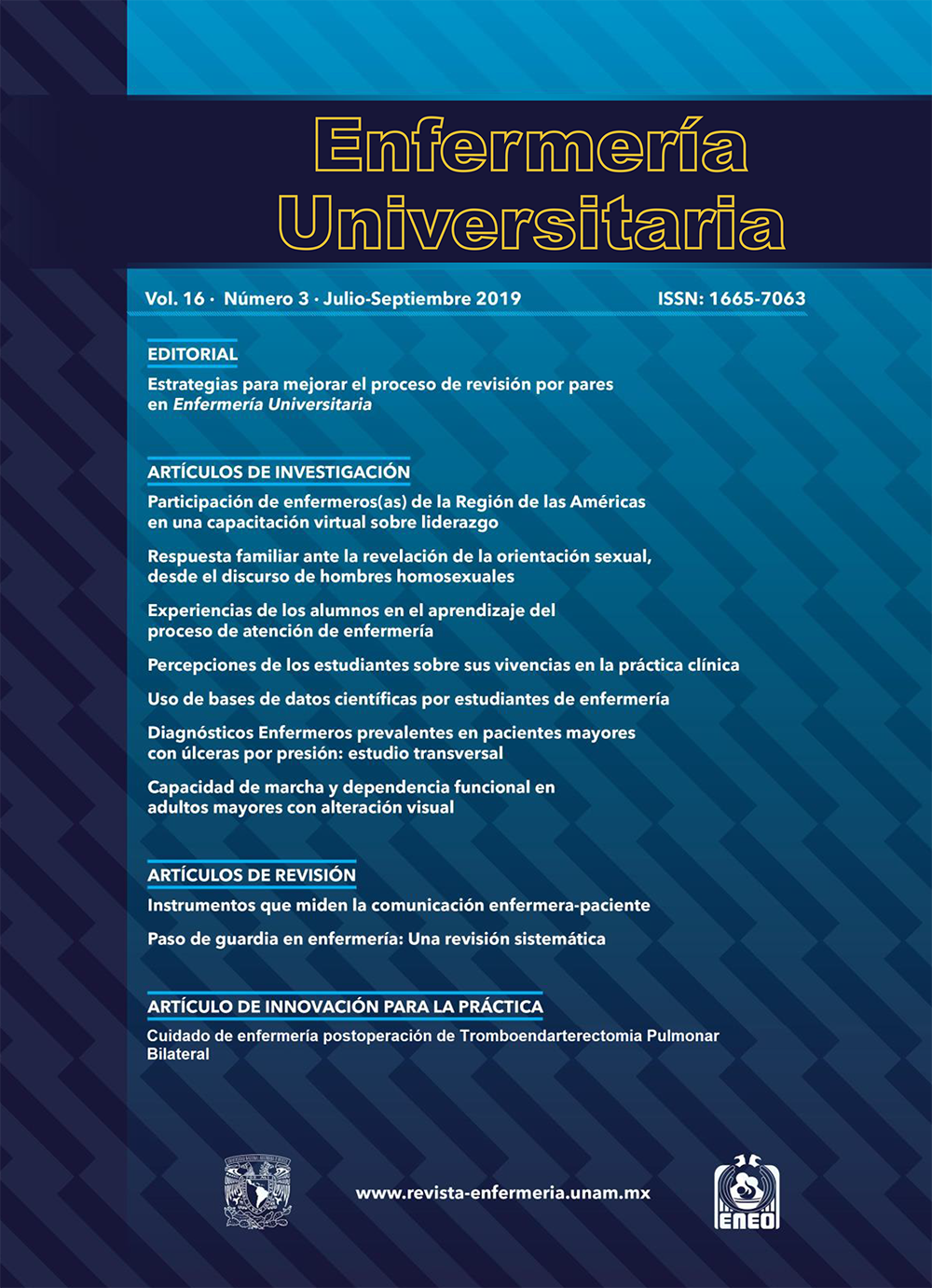Students' experiences on learning the Nursing Process
Main Article Content
Abstract
Introduction: The utilization of the Nursing Process (NP), as a methodology of the discipline which addresses the issues on nursing competences, allows reflexive interventions aimed at solving individual problems and integrally assisting the person, improves the communications, locates the professional scope by identifying the phenomena of interest, and gives a foundation to nursing research. Because of this, the NP constitutes a fundamental part in nursing education.
Objectives: a) To describe the undergraduate students' experiences regarding learning and using the Nursing Process during their academic formation; and b) To identify if the student acknowledges the process as the discipline's methodology to provide healthcare.
Methodology: This is a qualitative phenomenological and descriptive study. Participants were students from the third to the seventh semesters of a baccalaureate nursing program. In-depth interviews focused on how to learn and apply the Nursing Process were carried out. A discourse analysis with codification and decodification was developed until categories emerged.
Results: From the analysis, three categories emerged: a) Different worlds, which included three sub-categories: realizing, linking the theory and practice, and the influence from the nursing professional; b) Theoretical formation, which included two sub-categories: complex learning, and health and illness; c) Ambivalence of the professional while teaching NP, which included two sub-categories: teacher's heterogeneity and incongruity, and teacher's support.
Discussion and conclusion: In addition to the remarks on the differences between the theory and the practice related to NP, some student-nursing staff interactions do not particularly favor learning and utilizing the Nursing Process.
Publication Facts
Reviewer profiles N/A
Author statements
- Academic society
- N/A
- Publisher
- Universidad Nacional Autónoma de México
Article Details
Dimensions citation
MÉTRICAS
References
2. Potter PA, Griffin Perry A. Fundamentos de Enfermería, 2 vols. 5ª ed. España: Elsevier; 2002.
3. Hernández-Conesa JM. El método de Enfermería. En: Teorías y modelos de Enfermería, bases teóricas para el cuidado especializado. 2a ed. México: ENEO-UNAM; 2009.
4. Téllez-Ortiz SE. Método de enfermería: Herramienta importante para la aplicación de teorías de Enfermería. En: Téllez-Ortiz SE, García-Flores M (Coord). Modelos de cuidados en enfermería NANDA, NIC y NOC. México: McGraw-Hill Interamericana; 2012.
5. Rubio-Acuña M, Arias-Burgos M. Fenomenología y conocimiento disciplinar de enfermería. Rev. cuba enferm. 2013; 29(3): 191-98. https://bit.ly/2oQD2PC
6. Serrano JM, Pons-Parra RM. El constructivismo hoy: enfoques constructivistas en educación. Rev. electrón. investig. educ. 2011; 13(1). https://bit.ly/2aGIEpR
7. Escuela Nacional de Enfermería y Obstetricia. Reglamento General de Prácticas de Campo. México: ENEO-UNAM; 2006.
8. Aljama-Corrales E, Ostiguín-Meléndez RM. La enseñanza clínica en enfermería: un acercamiento multidisciplinario. México: IPN, CIECAS; 2007.
9. Díaz-Aguilar R, Amador-Morán R, Alonso-Uria RM, Campo-González A, Mederos-Dueñas M, Oria-Saavedra M. Evaluación del conocimiento del Proceso de Atención de Enfermería. Estudiantes de licenciatura de Enfermería. Facultad “Lidia Doce”. Enferm. univ. 2015; 12(1): 36-40. https://doi.org/10.1016/j.reu.2014.12.001
10. Alcaraz-Moreno N, Chávez-Acevedo AM, Sánchez-Betancourt EM, Amador-Fierros G, Godínez-Gómez R. Mirada del estudiante de enfermería sobre el aprendizaje y la aplicación del proceso de atención de enfermería. Rev. Enferm. Inst. Mex. Seguro Soc. 2015; 23(2): 65-74. https://bit.ly/2INW0yW
11. Fernandes-Gonzaga M, Batista-Dos Santos AD, Iwata-Monteiro A. O processo de enfermagem na concepção de profissionais de enfermagem de um hospital de ensino. Rev. Bras Enferm. 2013; 66(2): 167-73. http://dx.doi.org/10.1590/S0034-71672013000200003
12. Hagos F, Alemseged F, Balcha F, Berhe S, Aregay A. Application of Nursing Process and its affecting factors among nurses working in Mekelle Zone Hospitals, Northern Ethiopia. Nurs Res Pract. 2014; 2014. http://dx.doi.org/10.1155/2014/675212
13. Herrera-Restrepo D. Fenomenología y Hermenéutica. Folios. 2003; 17(1er Sem): 15 pag. https://doi.org/10.17227/01234870.17folios7.18
14. Hamui-Sutton A, Varela-Ruiz M. La técnica de grupos focales. Investigación educ. médica. 2013; 2(5): 55-60. https://doi.org/10.1016/S2007-5057(13)72683-8
15. Martínez-Salgado C. El muestreo en investigación cualitativa: principios básicos y algunas controversias. Cienc. Saude Colet. 2012; 17(3): 613-9. http://dx.doi.org/10.1590/S1413-81232012000300006
16. Pérez-Andrés C, Alameda-Cuesta A, Albéniz-Lizarraga C. La formación práctica en enfermería en la Escuela Universitaria de Enfermería de la Comunidad de Madrid. Opinión de los alumnos y de los profesionales asistenciales: Un estudio cualitativo con grupos de discusión. Rev. esp. salud pública. 2012; 76(5): 517-30. https://bit.ly/2WGiHdi
17. Escuela Nacional de Enfermería y Obstetricia. Plan de Estudios de la Licenciatura en Enfermería, México: ENEO-Universidad Nacional Autónoma de México; 2012.
18. Díaz-Barriga AF, Hernández RG. Constructivismo y aprendizaje significativo. En: Estrategias docentes para un aprendizaje. Una interpretación constructivista. 3ª ed. México: McGraw-Hill/Interamericana; 2010.
19. Laza-Vásquez C, Pulido-Acuña GP, Castiblanco-Montañez RA. La fenomenología para el estudio de la experiencia de la gestación de alto riesgo. Enfermería glob. 2012; 11(28): 295-305. https://bit.ly/2WPMGVq
20. Carrillo-Algarra AJ, García-Serrano L, Cárdenas-Orjuela CM, Díaz-Sánchez IR, Yabrudy Wilches N. La filosofía de Patricia Benner y la práctica clínica. Enfermería glob. 2013; 12(32): 346-61. https://bit.ly/2wTSLR5
21. Camacho-Franco ER, Rodríguez-Jiménez S. Una mirada crítica de la formación del profesional de enfermería con perspectiva reflexiva. Enferm. univ. 2010; 7(1) 37-44. https://doi.org/1022201/eneo.23958421e.2010.1.311
22. Fernandes-dos Santos M, Barbosa-Merighi MA, Muñoz LA. La enfermera clínica y las relaciones con los estudiantes de enfermería: un estudio fenomenológico. Texto contexto enferm. 2010; 9(1): 112-9. http://dx.doi.org/10.1590/S0104-07072010000100013

This work is licensed under a Creative Commons Attribution-NonCommercial-NoDerivatives 4.0 International License.
Enfermería Universitaria by Universidad Nacional Autónoma de México it is distributed under the License Creative Commons Attribution - NonCommercial - NoDerivatives 4.0 International
Accepted and published articles become open-access under the terms of the Creative Commons CC BY-NC-ND 4.0 license, which authorizes the reproduction and sharing without commercial purposes, provided the corresponding acknowledgments to their authors. Authors are allowed to manage a self-archive copy of the article’s published version so that they can open-access it in their personal or institutional web pages, and/or any other broad-diffusion space.


